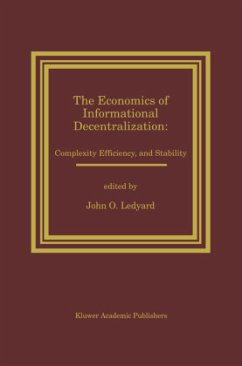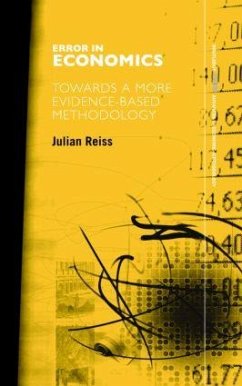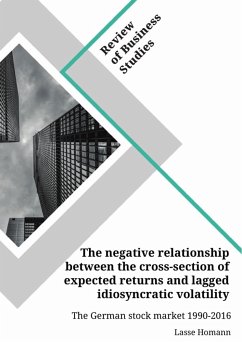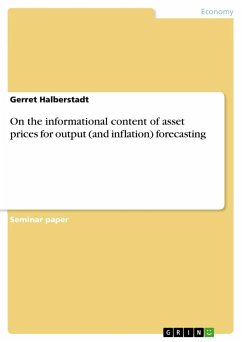
Fragile, Error-Prone And Idiosyncratic Behaviour: Informational Cascades
Versandkostenfrei!
Versandfertig in 1-2 Wochen
48,00 €
inkl. MwSt.

PAYBACK Punkte
0 °P sammeln!
Swiss Diploma Thesis from the year 2002 in the subject Economics - Macro-economics, general, grade: 1,5, University of Bern (Wirtschafts- und Sozialwissenschaften), language: English, abstract: Inhaltsangabe:Abstract:Macroeconomics deals with the behaviour of the economy altogether and concentrates on fundamental and actual economic problems. Microeconomics deals with the behaviour of individuals and the aggregation of their actions in different institutional frameworks. Thus, both micro- and macroeconomics are doctrines to describe and understand individuals behaviour, activities and outcomes...
Swiss Diploma Thesis from the year 2002 in the subject Economics - Macro-economics, general, grade: 1,5, University of Bern (Wirtschafts- und Sozialwissenschaften), language: English, abstract: Inhaltsangabe:Abstract:
Macroeconomics deals with the behaviour of the economy altogether and concentrates on fundamental and actual economic problems. Microeconomics deals with the behaviour of individuals and the aggregation of their actions in different institutional frameworks. Thus, both micro- and macroeconomics are doctrines to describe and understand individuals behaviour, activities and outcomes. So, why does one try to better understand? Individuals are curious , is a popular explanation. Another is that understanding may lead to a better outcome for individuals. There exist a lot of patterns of behaviour. One behaviour pattern is the so-called uniform behaviour. Imitation and mimicry belong to the basic instincts of every human being. Indeed, these patterns do not make immediate sense in terms of traditional macro- or microeconomic models. Still, they may be rational for an individual or a group of individuals. Learning by observing other individuals past actions and decisions may be of help to explain some otherwise puzzling phenomena about human behaviour. Apprehending individuals behaviour is not straightforward. It is not only profit or utility maximising that drives individuals minds. Sometimes, individuals just act because others act. An Informational Cascade is a situation in which every subsequent individual, based on the observation of others, makes the same choice or decision independent of his private information. Informational Cascades are present in our everyday life and in fields such as Economics, Politics, Scientific Theory, Finance or Zoology. The fact that this phenomenon does appear in innumerable situations is my motivation to closer examine Informational Cascades.
Economics and above all economic behaviour is more than Statistics or Mathematics. It is Anthropology and Psychology as well.
To combine and describe economics with the behaviour patterns of human beings, above all Informational Cascades and its environment , is the base of my licentiate.
To link this phenomenon to economics and to bring it in an economic context, one has to grasp what exactly an Informational Cascade does describe. Why can one define an Informational Cascade as a gap between the practiced and the preached? Definitions and a simple example are given at the beginning of chapter two, followed by a characterisation of an Informational Cascade.
The characterisation deals with the brittleness, idiosyncrasy and the error-sensitivity of Informational Cascades. Cascades are not just good for theory; indeed they do appear in empirical contents. This is illustrated at the end of chapter two, followed by an important tool to understand Informational Cascades: Bayes Rule.
The aim of chapter two is to provide the basics of Informational Cascades and to assure that the reader is prepared to conceive the periphery of this behaviour pattern.
Chapter three will deal with the crucial part of my work. It is dedicated to the dissection and classification of the literature dealing with Informational Cascades.
What areas, fields or realms influence and form Cascades?
This is the relevant question in the first part. One can subordinate Cascades to clusters such as Economics, Psychology, Sociology and others. In part two, I will dissect Cascades into well-known characteristics, specifications and theories, namely fads, fashions, herd behaviour, bubbles and crashes, and many others. I will also treat unorthodox phenomena such as the hush helix or the snob effect.
To show that an Informational Cascades environment is variegated and complex is this chapter s assignment.
This is illustrated on the overview map at the end of chapter three.
I will analyse...
Macroeconomics deals with the behaviour of the economy altogether and concentrates on fundamental and actual economic problems. Microeconomics deals with the behaviour of individuals and the aggregation of their actions in different institutional frameworks. Thus, both micro- and macroeconomics are doctrines to describe and understand individuals behaviour, activities and outcomes. So, why does one try to better understand? Individuals are curious , is a popular explanation. Another is that understanding may lead to a better outcome for individuals. There exist a lot of patterns of behaviour. One behaviour pattern is the so-called uniform behaviour. Imitation and mimicry belong to the basic instincts of every human being. Indeed, these patterns do not make immediate sense in terms of traditional macro- or microeconomic models. Still, they may be rational for an individual or a group of individuals. Learning by observing other individuals past actions and decisions may be of help to explain some otherwise puzzling phenomena about human behaviour. Apprehending individuals behaviour is not straightforward. It is not only profit or utility maximising that drives individuals minds. Sometimes, individuals just act because others act. An Informational Cascade is a situation in which every subsequent individual, based on the observation of others, makes the same choice or decision independent of his private information. Informational Cascades are present in our everyday life and in fields such as Economics, Politics, Scientific Theory, Finance or Zoology. The fact that this phenomenon does appear in innumerable situations is my motivation to closer examine Informational Cascades.
Economics and above all economic behaviour is more than Statistics or Mathematics. It is Anthropology and Psychology as well.
To combine and describe economics with the behaviour patterns of human beings, above all Informational Cascades and its environment , is the base of my licentiate.
To link this phenomenon to economics and to bring it in an economic context, one has to grasp what exactly an Informational Cascade does describe. Why can one define an Informational Cascade as a gap between the practiced and the preached? Definitions and a simple example are given at the beginning of chapter two, followed by a characterisation of an Informational Cascade.
The characterisation deals with the brittleness, idiosyncrasy and the error-sensitivity of Informational Cascades. Cascades are not just good for theory; indeed they do appear in empirical contents. This is illustrated at the end of chapter two, followed by an important tool to understand Informational Cascades: Bayes Rule.
The aim of chapter two is to provide the basics of Informational Cascades and to assure that the reader is prepared to conceive the periphery of this behaviour pattern.
Chapter three will deal with the crucial part of my work. It is dedicated to the dissection and classification of the literature dealing with Informational Cascades.
What areas, fields or realms influence and form Cascades?
This is the relevant question in the first part. One can subordinate Cascades to clusters such as Economics, Psychology, Sociology and others. In part two, I will dissect Cascades into well-known characteristics, specifications and theories, namely fads, fashions, herd behaviour, bubbles and crashes, and many others. I will also treat unorthodox phenomena such as the hush helix or the snob effect.
To show that an Informational Cascades environment is variegated and complex is this chapter s assignment.
This is illustrated on the overview map at the end of chapter three.
I will analyse...














